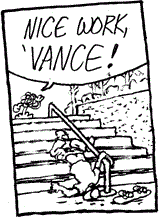You probably know more people who suffer from mental illness than you realize. People rarely discuss their mental issues in casual company. It’s a sensitive subject, something usually kept private. Being open about one’s own mental issues means being open to uncomfortable scrutiny and judgement. Too many people don’t even seek treatment for mental illness because of societal pressures to be “normal” and deny any aspect of themselves that does not live up to the standard of normalcy. Given this social milieu of denial and suppression, it’s wonderfully refreshing to find a comic like I Do Not Have an Eating Disorder.
I Do Not Have an Eating Disorder is a journal comic about a woman’s struggle with anorexia. Eating disorders are particularly prone to social stigmatization, and are closely linked with issues of identity, self-perception, and social perception. The reluctance to talk about personal experience with these issues results in a negative feedback loop whereby people become more reluctant to talk about their experiences or to even admit their experiences to themselves. The title of this comic is an outright denial of the comic’s subject matter, reflecting the author’s difficulty in coming to accept the truth of her condition.
This is a story that is rarely told, since few who’ve gone through these kind of experiences want to talk about it. Relating painful memories is difficult, so for that reason, along with fear of judgement, most people remain silent. I’m extremely grateful to have this comic available, providing a brave and thorough exploration of what it’s like to go through the process of identifying a problem and starting recovery.
I can see a lot of myself in this comic, even though I’ve never had an eating disorder. Unhealthy coping mechanisms for stress and depression are things that I do have experience with, and they’re not things that people really talk about all that often. Again, the social stigma of admitting that one is dealing with these problems prevents people from realizing how common these problems are. I Do Not Have an Eating Disorder can be a comforting read, from that perspective. Here is a person with problems who feels alone for having problems. I‘m willing to bet that even mentally and emotionally healthy people feel this way sometimes, and I think that the more open we are as a culture to talking about inner turmoil, as painful as it may be, the easier we will all find it to deal with these problems openly and honestly.
I Do Not Have an Eating Disorder is raw and honest. There’s a lot of inconsistency as the comic progresses, because the author is still processing her experience and recovering. At the beginning, certain things are only subtly alluded to, and as time goes by those things are directly addressed. Later pages sometimes reflect on attitudes from earlier pages and how the author has changed in the meantime. It’s a fascinating glimpse into a mind as it adjusts to new understanding and new practices.
There’s a lot in I Do Not Have an Eating Disorder about assumptions, the kind that people make about what is normal/abnormal, about what kinds of things are healthy or what sources of information are reliable. Even assumptions about our own abilities of perception can be dangerous, and the author has to unlearn a lot of things over the course of her journey.
 |
| Some people do lose their appetites when stressed. Some people eat more! Humans are variable and weird. |
One of the biggest challenges in this comic is fear. Fear prevented the author from receiving treatment for a long time. Fear made recovery more difficult. Fear led to a lot of the problems she’s had to deal with in the first place. There’s even a great deal of fear regarding the creation and sharing of the comic itself. In a way, I view I Do Not Have an Eating Disorder as a triumph over fear. The author may still have difficulties, but the mere act of creating this comic about such a personal and emotionally loaded subject, and sharing that comic with the world, strikes me as a huge step forward. I am so glad that it is available for the rest of us to see.
I Do Not Have an Eating Disorder is written and drawn by Khale McHurst and typically updates with a new page over the weekend. Since it’s on Tumblr and doesn’t have a dedicated website, the archive can be a little tricky to navigate. Starting at the beginning and reading through is pretty easy, thanks to navigating links on each post, but the nature of Tumblr means that having a “latest page” button is pretty much out of the question. I tend to just bookmark the last page and then update the bookmark when a new page goes up, which is kind of labor-intensive, but, I think, worth it.
I recommend this comic to anyone who has ever had a problem that they were scared to bring up with other people. (If you think that description doesn't apply to you then I suspect you are lying to yourself.)



























